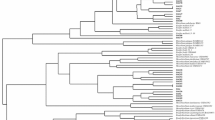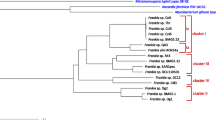Abstract
Astragalus cicer (cicer milkvetch) nodule bacteria were investigated for host plant specificity and partial nodC gene sequences, whilst their native host was studied for the microscopic structure of root nodules. The strains under investigation formed nodules not only on the original host but also on Astragalus glycyphyllos, Astragalus sinicus, Lotus corniculatus, and Phaseolus vulgaris. The nodules induced on the cicer milkvetch were classified as indeterminate and characterized by apical, persistent meristem, a large bacteroid region with infected and uninfected cells, and elongated bacteroids singly located inside peribacteroid membranes. By comparison of the partial nodC gene sequences of a representative strain of astragali rhizobia to those contained in the GenBank database, a close symbiotic relationship of A. cicer microsymbionts to Rhizobium sp. (Oxytropis) was found.
Similar content being viewed by others
References
Chen WX, Li GS, Qi YL, Wang ET, Yuan HL & Li JL (1991) Rhizobium huakuii sp. nov. isolated from the root nodules of Astragalus sinicus. Int. J. Syst. Bacteriol. 41: 275–280
Cloutier J, Laberge S, Prevost D & Antoun H (1996) Sequence and mutational analysis of the common nodBCIJ region of Rhizobium sp. (Oxytropis arctobia) strain N33, a nitrogen-fixing microsymbiont of both arctic and temperate legumes. Mol. Plant Microbe. 9: 523–531
Downie JA (1998) Rhizobial nodulation genes. In: HP Spaink, A Kondorosi & PJ Hooykaas (Eds) The Rhizobiaceae (pp 387–402). Kluwer Academic Publishers, Dordrecht
Felsenstein J (1993) PHYLIP - Phylogeny Inference Package, version 3.572c. Department of Genetics, University of Washington, Seattle, Washington
Higgins DG & Sharp PM (1988) Clustal: a package for performing multiple alignment on a microcomputer. Gene 73: 237–244
Hirsch AM (1992) Development biology of legumes. New Phytol. 122: 211–237
Laguerre G, van Berkum P, Amarger N & Prevost D (1997) Genetic diversity of rhizobial symbionts isolated from legume species within the genera Astragalus, Oxytropis and Onobrychis. Appl. Environ. Microbiol. 63: 4748–4758
Ledingham GF & Rever BM (1963) Chromosome numbers of some Southwest Asian species of Astragalus and Oxytropis (Leguminosae). Can. J. Genet. Cytol. 5: 18–32
Małek W (1974) Relationship between phage sensitivity and symbiotic properties of auxotrophic mutants of Rhizobium meliloti. Acta Microbiol. Polon. 6: 225–229
Małek W & Sajnaga E (1999) Current taxonomy of the rhizobia. Acta Microbiol. Polon. 48: 109–122
Murooka Y, Xu Y, Sanoda K, Araki M, Morinaga T & Yokota A (1993) Formation of root nodules by Rhizobium huakuii biovar renge bv. nov. on Astragalus sinicus cv. Japan. J. Ferment. 76: 38–44
Newcomb W & Wood SM (1986) Fine structure of nitrogen-fixing leguminous root nodules from the Canadian arctic. Nord. J. Bot. 6: 609–626
Novikova NI, Pavlova EA & Limeshchenko EV (1993) Phage sensitivity and host range of rhizobium strains isolated from root nodules of temperate legumes. Plant Soil 151: 45–53
Novikowa NI, Pavlova E, Vorobjev NI & Limeshchenko EV (1994) Numerical taxonomy of Rhizobium strains from legumes of the temperate zone. Int. J. Syst. Bacteriol. 44: 734–742
Nuswantara S, Fujie M., Yamada T, Maüek W, Inaba M., Kaneko Y & Murooka Y (1999) Phylogenetic position of Mesorhizobium huakuii subsp. rengei, a symbiont of Astragalus sinicus cv. Japan. J. Biosci. Bioeng. 87: 49–55
Polhill RM & Raven PH (1981) Advances in legume systematics, part 1. Royal Botanic Gardens, Kew, England
Prevost D, Bordeleau LM & Antoun H (1988) Effect des souches arctiques de Rhizobium sur la structure des nodules du sainfoin (Onobrychis viciifolia) et de legumineuses arctiques (Astragalus et Oxytropis spp.). Can. J. Bot. 67: 3164–3168
Saitou N & Nei M(1987) A neighbor-joining method: a new method for reconstructing phylogenetic trees. Mol. Biol. Evol. 44: 406–425
Sambrook JE, Fritsch F & Maniatis T (1989) Molecular cloning: a laboratory manual. Cold Spr. Harb. Lab. Press, USA
Ueda T, Suga Y, Yahiro N & Matsuguchi T (1995) Phylogeny of Sym plasmids of rhizobia by PCR-based sequencing of a nodC segment. J. Bacteriol. 177: 468–472
Wernegreen JJ & Riley MA (1999) Comparison of the evolutionary dynamics of symbiotic and housekeeping loci: a case for the genetic coherence of rhizobial lineages. Mol. Biol. Evol. 16: 98–113
Young JPW & Johnston AW (1989) The evolution of specificity in the legume-rhizobium symbiosis. Trends Ecol. Evol. 4: 341–349
Yong JP & Haukka KE (1996) Diversity and phylogeny of rhizobia. New Phytol. 133: 87–94
Zhao Z, William SE & Schuman GE (1997) Renodulation and characterization of Rhizobium isolates from cicer milkvetch (Astragalus cicer L.). Bio. Feril. Soils 25: 169–174
Author information
Authors and Affiliations
Corresponding author
Rights and permissions
About this article
Cite this article
Wdowiak, S., Małek, W., Sajnaga, E. et al. Symbiosis of Astragalus cicer with its microsymbionts: partial nodC gene sequence, host plant specificity, and root nodule structure. Antonie Van Leeuwenhoek 78, 63–71 (2000). https://doi.org/10.1023/A:1002738609114
Issue Date:
DOI: https://doi.org/10.1023/A:1002738609114




